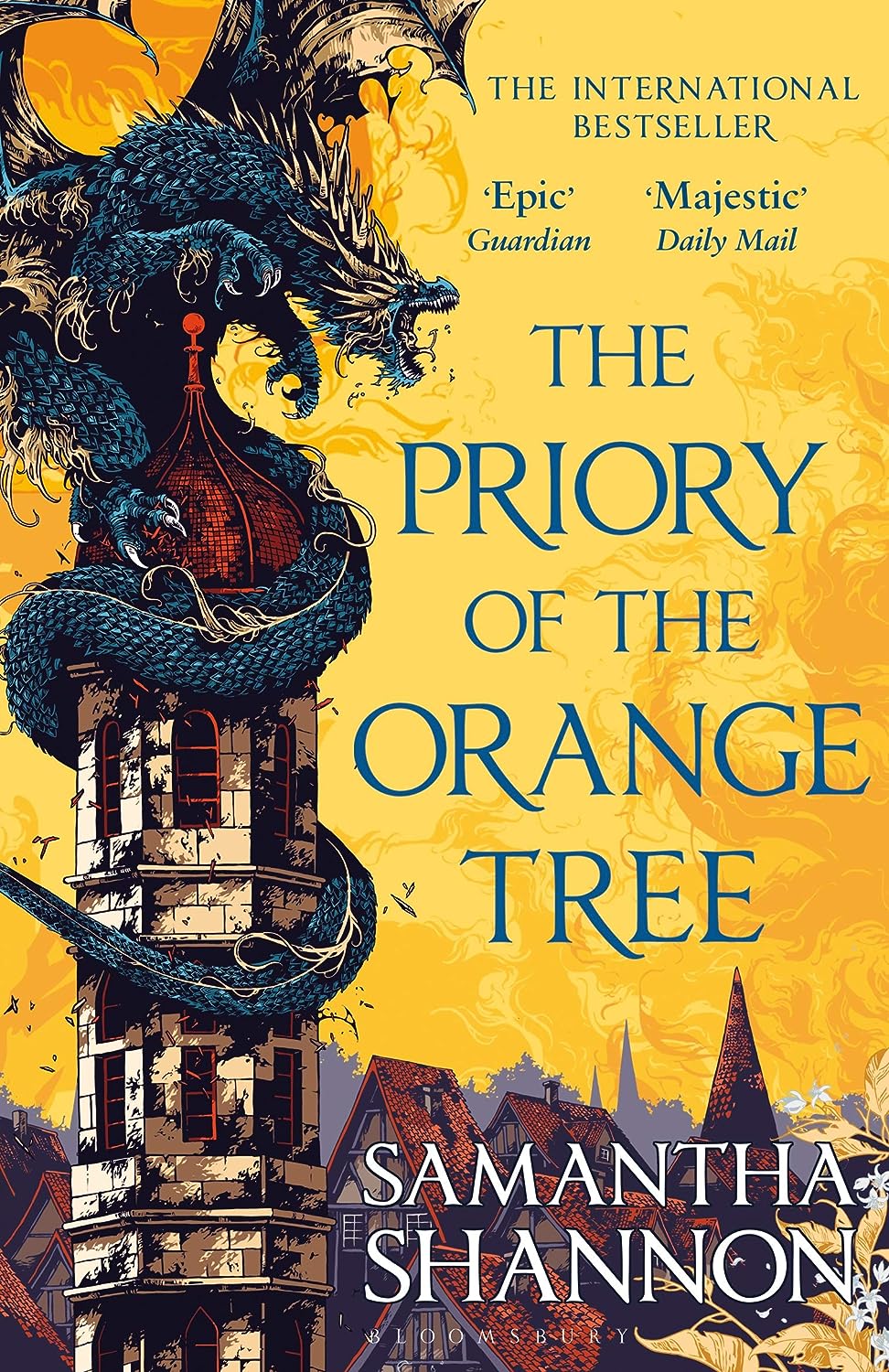
The Priory of the Orange Tree
Fourteen
by Shannon, SamanthaThe chapter opens with a flurry of preparations in Ascalon Palace as Queen Sabran prepares to welcome Aubrecht Lievelyn and his retinue, signaling her serious consideration of his marriage proposal. The palace buzzes with activity, from food deliveries to new gowns being crafted, while Ead, still recovering from illness, struggles to keep up with her duties. Amid the excitement, she remains vigilant for the arrival of her mentor, Chassar uq-Ispad, and notes the absence of further rumors about sorcery involving Truyde utt Zeedeur.
Ead observes the influx of courtiers, including Earls Provincial and their families, and overhears a revealing conversation between Lord Ranulf Heath and Lady Igrain Crest. Their discussion centers on the political implications of Sabran’s betrothal and the urgency of producing an heir. Crest expresses concern over Sabran’s independence, hinting at her diminishing influence over the queen. The exchange underscores the court’s preoccupation with securing the Berethnet lineage, with little regard for the personal dynamics between Sabran and Lievelyn.
As Ead reflects on the conversation, her suspicions about the court’s spymaster, Seyton Combe, deepen. She theorizes that the recent failed assassination attempts on Sabran may have been orchestrated by Combe himself—not to kill her, but to manipulate her into accepting the marriage. The staged nature of the attacks and Combe’s control over the court’s secrets align with his calculated methods. Ead realizes her interventions may have disrupted his plans, explaining his efforts to uncover her identity.
The chapter concludes with Ead resolving to gather evidence against Combe, confident in her intuition but aware of the risks. She recognizes the need for caution, as Combe’s influence looms large over the throne. Her determination to protect Sabran and expose the spymaster’s machinations sets the stage for a covert battle of wits, with the stability of the queendom hanging in the balance.
FAQs
1. What evidence suggests that Combe may be orchestrating the attacks on Queen Sabran?
Answer:
Ead deduces Combe’s potential involvement through several observations: the staged nature of the attacks (cutthroats consistently botching their attempts), Combe’s control over interrogations and disposal of captured assailants, and his access to palace security (providing a key to the Secret Stair). Most tellingly, the attacks align with Combe’s motives—frightening Sabran into accepting Lievelyn’s marriage proposal to secure an heir, thereby maintaining political stability. The cessation of attacks after the betrothal suggests their purpose was manipulation rather than assassination (pp. 155-156).2. How does Ead’s role as Sabran’s protector conflict with Combe’s suspected plans?
Answer:
Ead unwittingly disrupts Combe’s scheme by neutralizing the cutthroats before they can fully terrorize Sabran. Her interventions force Combe to escalate (e.g., providing the Secret Stair key) and obscure his intended psychological manipulation. This creates tension, as Combe now seeks to identify the “anonymous protector” undermining his control. Ead’s actions reveal her dual challenge: protecting Sabran from physical harm while navigating the political machinations of the court (pp. 155-156).3. Analyze the significance of the betrothal preparations in highlighting Inysh priorities.
Answer:
The lavish preparations—800 retinue members, imported delicacies, and palace refurbishments—emphasize Inys’s fixation on political alliances over personal compatibility. As Ead notes, the court cares little whether Sabran and Lievelyn know each other, so long as the marriage produces an heir to “tighten the Chainmail of Virtudom” (p. 154). Lady Crest’s dialogue underscores this, stressing Sabran’s duty to bear a child over her autonomy. The spectacle reflects a society prioritizing dynastic continuity and symbolic unity over individual agency.4. What does Ead’s observation about Truyde utt Zeedeur reveal about her current priorities?
Answer:
Ead’s relief that Truyde is “keeping her head down” (p. 153) indicates her primary focus is maintaining her own secrecy as a mage while protecting Sabran. The absence of sorcery rumors allows Ead to operate without additional scrutiny. This brief mention contrasts with the political intrigue elsewhere, reminding readers that Ead’s safety—and thus her ability to guard Sabran—depends on the court’s distraction with the betrothal festivities.5. How does the chapter develop the theme of surveillance and hidden power structures?
Answer:
The chapter juxtaposes overt displays of power (preparations for Lievelyn’s arrival) with covert control mechanisms. Combe’s suspected manipulation through staged attacks mirrors Crest’s subtle influence over Sabran’s decisions, while Ead eavesdrops on their conversation—a literal act of surveillance. The recurring hawk imagery (Combe’s “Night Hawk” epithet, Crest’s remark about hawks’ blind spots) reinforces this theme, illustrating how power operates through both visibility and secrecy in the Inysh court (pp. 154-155).
Quotes
1. “Excitement burned through the palace like a ground fire.”
This quote captures the electric atmosphere at court as preparations for Queen Sabran’s betrothal reach fever pitch. It marks a turning point where the political marriage appears to be moving from possibility to reality.
2. “Few Inysh seemed to care whether Sabran and Lievelyn knew each other from a stuffed capon, so long as they were wed.”
This biting observation reveals the political pragmatism surrounding the royal marriage. Ead’s commentary highlights how the court prioritizes dynastic security over personal compatibility between the monarchs.
3. “It is vital that we have an heir as soon as possible. Her Majesty knows her duty on that front.”
Lady Igrain Crest’s blunt statement encapsulates the central pressure on Queen Sabran. This quote represents the reproductive imperative driving the political machinations throughout the chapter.
4. “In chaos like that, the Night Hawk could rise.”
Ead’s realization about potential motives behind the assassination attempts reveals the dangerous power vacuum that could follow Sabran’s death. This marks a key moment in her developing conspiracy theory about Combe’s possible involvement.
5. “Ead meant to clip them. All she needed was the evidence—and the opportunity.”
This decisive closing thought shows Ead transitioning from passive observer to active player in court politics. It sets up her future actions against Combe’s scheming and represents her growing agency in protecting the queen.
